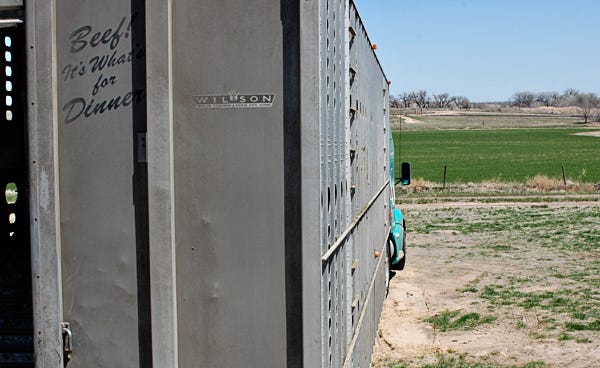You can do more than just get wet with a walk in the rain. Find out why in this week’s Trending Headlines.

Walkin’ in the rain, scoutin’ in the pasture
Victor Shelton is not opposed to walking in the rain. In fact, writing for onpature.com, he says, “I’ve probably spent too much time walking fields, especially when it is raining. It’s not the most enjoyable thing to do in the winter time, especially in a cold rain, but it is educational.”
The amount of residue and/or forage residual left behind and how it stands makes an impact on runoff. The more retardance, something that breaks impact and slows movement, the less runoff. The more retardance, the more likely the increased intake or infiltration of water, unless the ground is frozen or compacted.
Tightly grazed or overgrazed pastures have little retardance, so they also have increased runoff. Sadly, this also means poor plant stands, poor roots, and almost always, compaction. Lack of residue, live plants and roots with compacted layers restricting natural soil drainage are usually some of the muddiest areas under wet winter conditions. The combination usually means major pugging and mud.
Does the U.S. really need to take on NAFTA?
"I think meat industries in general and the beef industry perhaps in particular, is somewhat nervous about the idea of any disruptions or changes in the trade relationship we have right now," says Derrell Peel, Extension livestock marketing economist at Oklahoma State University. "NAFTA has been a pretty good deal for the meat industry, so I think there is relatively little room for improvement."
According to Peel, Mexico is not only one of the major export destinations for U.S. beef, it is also a key source for our beef imports. Add pork and poultry to that equation and Peel says Mexico accounts for 24% of our total meat export business, according to the Oklahoma Farm Report.
"Any sort of disruption in any of those markets would have significant implications back home in the domestic market," Peel claims. "(Markets) continue to evolve and anything you change from that is probably going to be a step backwards from that in term of the meat industries."
Click here to listen to Peel’s thoughts on why reopening NAFTA is a bad idea.
If you’re a beef producer, you’re in the business of keeping promises

"Alignment is the future of protein," says John Butler, with the Beef Marketing Group in Manhattan, Kan. "We're going to need to be more aligned with where the animals begin, all the way until they become in the meat case or on the menu and actually tie that promise."
Butler contends this is a natural progression for the beef industry, basing his thoughts on extensive research conducted by the Beef Marketing Group, working to understand what consumers want from the beef products they purchase. He says through this research, the industry has been able to build upon a continual effort to improve the supply chain, according to the Oklahoma Farm Report.
"As a result, we think we've built a more sustainable model, from a business perspective," Butler says, "and are able to extract additional value than just the normal commodity model that's out there today."
Update: Imports of Canadian slaughter and feeder cattle negligible
Imports of feeder cattle from Canada were quite small during the first five weeks of 2017, not unusual for this time of year. Imports of fed steers and heifers also were lower despite the higher prices and the favorable exchange rate, according to the Daily Livestock Report.
The decline in slaughter cattle imports is due in large part to the smaller number of cattle on feed in Canadian feedlots. Shipment of slaughter-ready cattle to the U.S. market during the first five weeks of this year were 23,915 head, 26% lower than the same period a year ago. Fed cattle slaughter in the U.S. at this time of year is running at around 90,000 head per day. So overall imports of slaughter cattle from Canada in the first five weeks of this year represent about 1% of U.S. fed cattle slaughter.
“Alternative Facts” aside, beef imports have little market impact

Despite “alternative facts” of beef imports flooding the U.S. market, the reality is that beef imports have had a very minor effect on U.S. beef and cattle prices in the last 12 months. Here’s what the numbers show, according to the Daily Livestock Report.
The United States imported a little over 3 billion pounds of beef (carcass weight basis) in 2016. That’s a lot of beef and, out of context, it can be made to look like torrent of product. Keep in mind that U.S. consumers bought, in one form or another, 25.8 billion pounds of beef last year.
Imports were 11.7% of the beef consumed in the U.S. in 2016. Even this paints an incomplete picture. Much of the beef that we imported was offset by beef that we exported to the rest of the world. U.S. beef exports last year were 2.55 billion pounds, meaning that the net difference between imports and exports last year was just 466 million pounds, or 2% of the beef consumed domestically in the U.S. last year.
Click here for the rest of the story on the impact of beef imports.
Organic livestock standards on hold
In accordance with President Trump’s order to halt implementation of any “midnight” rulemaking by the Obama administration, USDA’s Agricultural Marketing Service (AMS) is delaying the effective date of the Organic Livestock & Poultry Practices (OLPP) final rule by 60 days until May 19, 2017, Feedstuffs reports.
In a statement, the Organic Trade Association, “This final rule has received strong support throughout the organic chain, from organic producers to the organic consumer. The vast majority of organic livestock and poultry operations, including egg producers both large and small, and most major organic brands fully support these organic standards and view them as essential. Consumers trust that the organic seal represents a meaningful differentiation from other agricultural practices and fully support these standards.
About the Author(s)
You May Also Like



